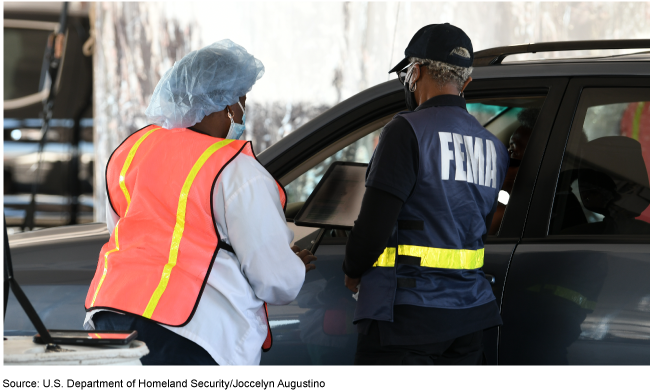FEMA Workforce: Long-Standing and New Challenges Could Affect Mission Success
Fast Facts
FEMA has long been tasked with the difficult job of leading the federal response to natural disasters. We testified about challenges facing its workforce.
The frequency of disasters is increasing but FEMA has staffing shortages. Many responders have declined deployments to recent disasters because of burnout or severe conditions in the field. FEMA also has challenges ensuring staff are sufficiently trained and qualified.
We've made numerous recommendations in prior reports to help FEMA better ensure it is able to manage a catastrophic disaster or concurrent disasters. FEMA is taking steps to address them.
FEMA worker at COVID-19 vaccination site in February 2021

Highlights
What GAO Found
GAO's past work has identified longstanding challenges facing the Federal Emergency Management Agency's (FEMA) workforce. In May 2020, for example, GAO reported on the following workforce challenges within FEMA:
Staffing shortages. The 2017 and 2018 disaster seasons created unprecedented demand for FEMA's workforce. FEMA deployed over 10,000 personnel during the peak of each season but faced shortages in over half of its cadres—operational or programmatic groups—when disasters began. For example, 18 of 23 cadres operated with 25 percent or less of staff available to deploy when Hurricane Maria made landfall in 2017. In addition, many employees—up to 48 percent in some cases—declined deployments due, according to FEMA officials, to burnout and austere conditions in the field.
Workforce qualifications. GAO found that FEMA faced challenges deploying staff with the right qualifications and skills at the right times to meet disaster needs. Qualification status in FEMA's systems was not a reliable indicator of staff's ability to perform in the field. For example, in 14 of the focus groups GAO held with FEMA staff, participants said that staff who were designated as qualified in FEMA's system did not always have the necessary skills for their position. GAO recommended that FEMA develop a plan to address challenges in providing quality information to field leaders about staff qualifications. FEMA told GAO in December 2021 that its Field Operations Directorate has created plans to inform field leadership about staff skills and abilities, among other things. GAO also recommended that FEMA develop mechanisms to assess deployment outcomes. FEMA said it is modifying its force structure targets, with input from field leadership, and has implemented continuous data collection efforts.
Staff development. GAO found shortcomings in FEMA's ability to ensure staff training and development for the skills needed in the field. For example, Reservists—often comprising the greatest proportion of FEMA staff in the field during a disaster—faced barriers to staff development and inconsistently received performance evaluations. GAO recommended that FEMA create a staff development program that addresses access to training, development, and feedback. In response, FEMA has taken a number of steps, including process improvements for development opportunities and creating a plan to consistently conduct performance reviews.
GAO will continue to monitor FEMA's actions and assess the extent to which these actions address GAO's recommendations.
These workforce challenges can affect FEMA's ability to achieve its mission to help people before, during, and after disasters. For example, GAO has reported on challenges with inadequate training and low morale for Disaster Recovery Center call center employees. Improving training and employee engagement and morale may help improve services provided to disaster survivors.
With an increase in the frequency and cost of disasters, and with FEMA supporting numerous efforts outside of its normal core responsibilities, GAO is concerned that FEMA personnel may not be prepared to manage a catastrophic natural disaster or concurrent disasters.
Why GAO Did This Study
FEMA has long been tasked with the difficult job of leading the federal response to natural disasters. The increasing frequency of disasters and the additional responsibilities of responding to the COVID-19 pandemic and other events have stretched the FEMA workforce in unprecedented ways.
This testimony discusses GAO's prior work on various FEMA workforce challenges. This statement is based on products GAO issued from July 2015 to August 2021. For those products, GAO reviewed and analyzed federal law, federal data, and agency documentation and interviewed federal, state, and local officials as well as representatives of stakeholder groups impacted by disasters. GAO also conducted some of these interviews as part of visits to locations affected by hurricanes in 2017 and 2018. Additionally, GAO conducted 17 focus groups with FEMA staff.
Recommendations
GAO has made numerous recommendations in prior reports designed to address the workforce challenges discussed in this testimony. FEMA has taken steps to address these recommendations and GAO is monitoring FEMA's ongoing efforts.
